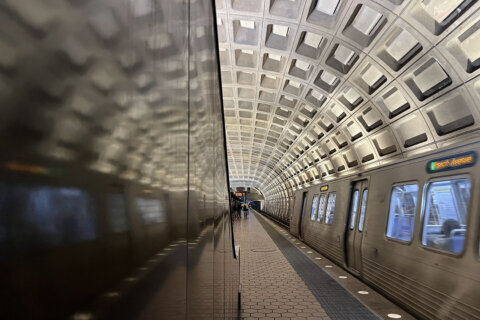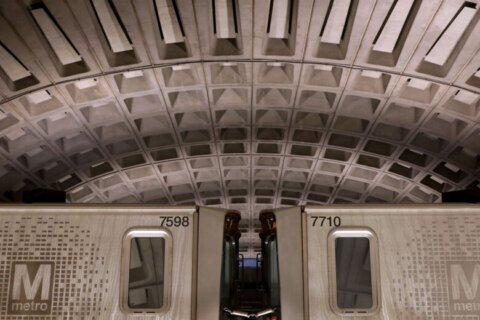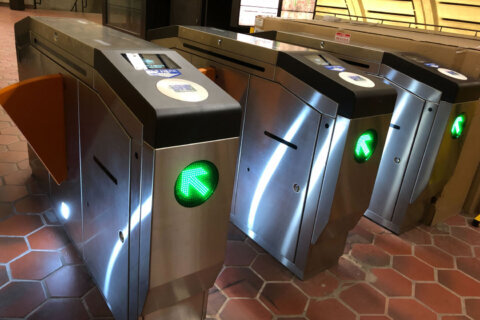WASHINGTON — A three-judge appellate panel appeared Wednesday to look for a narrow legal way to allow Purple Line light rail construction to continue in Maryland.
The high-powered panel of the U.S. Court of Appeals D.C. Circuit pressed attorneys for Maryland, the Federal Transit Administration and opponents of the 16-mile, 21-stop light rail line during arguments over the environmental review of the project.
The appeals court stepped in over the summer to lift a lower court’s ruling that had held up construction by ordering the state and federal government to do an additional environmental review. This came after opponents of the line raised questions about how Metro’s recent ridership decline might impact ridership on the state-backed, privately built and operated Purple Line.
“I think the answer is clear, so I am very hopeful after this hearing,” Greg Sanders, a leader of the advocacy group Purple Line NOW said outside the courthouse.
“I hope they draw a precedent that keeps this from happening to other transit programs where anyone with an objection and enough lawyers can delay a project for an entire year, it’s ridiculous,” he said.
Lead plaintiff John Fitzgerald also said he felt pretty good after the arguments.
“One of the key questions is, do you need to continue to assess alternatives based on changing dynamics — financial dynamics or technology dynamics — different kinds of choices or combinations?” Fitzgerald said.
Eric Glitzenstein, arguing for Fitzgerald and other opponents of the project, argued in court that construction should be stopped again since trees are being cut down and neighbors are seeing construction while court challenges are pursued.
Any decision in the case could have wide-ranging impacts on challenges to transit projects across the country, since it could set the basis for any future court battles tied to the National Environmental Policy Act.
Since the line will allow people who live in Prince George’s County to reach jobs in Montgomery County, and could limit time spent in traffic, Chief Judge Merrick Garland asked Glitzenstein why the Metro issues were so significant.
“We’re only asking a narrow NEPA question … [but] if it actually accelerates the decline of the Metro system, that would have an enormous impact,” Glitzenstein said.
Garland questioned how allowing people more direct trips between Bethesda, Silver Spring, College Park and New Carrollton would do that.
Judge Judith Rogers said questions about Metro have “risen in a very dramatic way in recent times,” and joined Garland to ask about the hypothetical situation where Metro ceases to exist. Also, Federal Transit Administration lawyer Kevin McArdle and Maryland lawyer Albert Ferlo pointed to the numerous studies done on the Purple Line that show it would be a valuable project anyway.
“The need for east-west transit in the corridor hasn’t changed,” McArdle said.
“No one in this case has suggested the possibility that Metro ceases to exist,” Ferlo said.
Even if it did, state studies show enough Purple Line ridership to justify the project.
“NEPA doesn’t require agencies to engage in endless speculation,” Ferlo told Judge Sri Srinivasan.
“If there are no riders and people aren’t riding Metro, then people are moving around by other means,” Ferlo said. “There are 21 stations on this line … and as the population level rises, the need becomes even more critical.”
McArdle eventually agreed with Garland that there could be some dramatic case where a new environmental review could be required in the event of a complete change that rendered all initial assumptions obsolete, a theory that could allow the Purple Line project to move forward without foreclosing challenges to other projects in the future.
Rogers and Garland suggested that nothing in expert reports submitted by opponents of the line in the legal case was actually new, as required to prompt an additional environmental review, and instead the court was being asked to simply reconsider the wisdom of construction.
“Where is this number as to what the new ridership is likely to be, and where is it supported?” Garland asked Glitzenstein, who responded that the opponents believe Maryland’s numbers have been inconsistent over the many years the Purple Line project has been studied.
If there are no additional delays, the light rail line and a rebuilt trail alongside it are due to open by summer 2022.
Editor’s note: This story has been updated to correct the spelling of Greg Sanders’ name.







